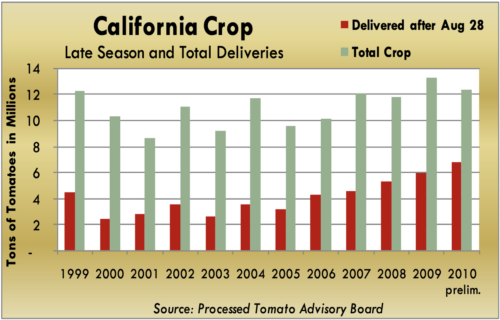 California’s tomato growers and processors might be too good for their own good. Once again the world’s largest production area packed an above average crop, creating an excess supply.
California’s tomato growers and processors might be too good for their own good. Once again the world’s largest production area packed an above average crop, creating an excess supply.
Although final numbers have not yet been released, the crop is expected to top 12.3 million tons— potentially edging out California’s 1999 crop as the second largest on record. The 2010 crop is about 7% below last year’s record setting 13.3 million ton crop.
What makes the 2010 crop amazing is the yield, especially since most of the crop was processed late. It appears growers averaged record‐breaking yields of over 45 tons per acre on the 269,000 acres contracted. When all the dust settles and the final numbers are in, the 2010 yield could be at least 2 tons per acre more than last year’s high of 43.2 tons per acre.
The record high yields are stunning given the difficult early season faced by growers and the volume of tomatoes harvested later in the season. Early in the season, the weather was not cooperating. The spring suffered under winter‐like temperatures and late rainfall which delayed transplanting and pushed the start of the season back two weeks. The first few weeks of tomatoes, which arrived at the factories in late July, were damaged by disease and speck.
Usually when a tomato crop gets off to a late start, processors face issues with “bunching”. Bunching happens when some fields ripen behind schedule and need processing at the same time as tomatoes already scheduled for that time period. Luckily, this summer, the weather stayed very mild and none of the tomatoes were ready on time which pushed back the entire crop.
As a result, the crop was very behind expectations in August, and appeared it would fall short by at least a million tons. But a cool summer allowed the vines to set fruit unharmed by high temperatures, and the late crop developed above average yields.

Morning Star Newsletter now distributed electronically
As a reminder, Morning Star is now distributing our newsletters electronically using an email distribution vendor called Mailchimp. Your e-version will now include informative Morning Star videos and highlights. Depending on your company's firewall, these emails may initially be directed to you spam folder.

